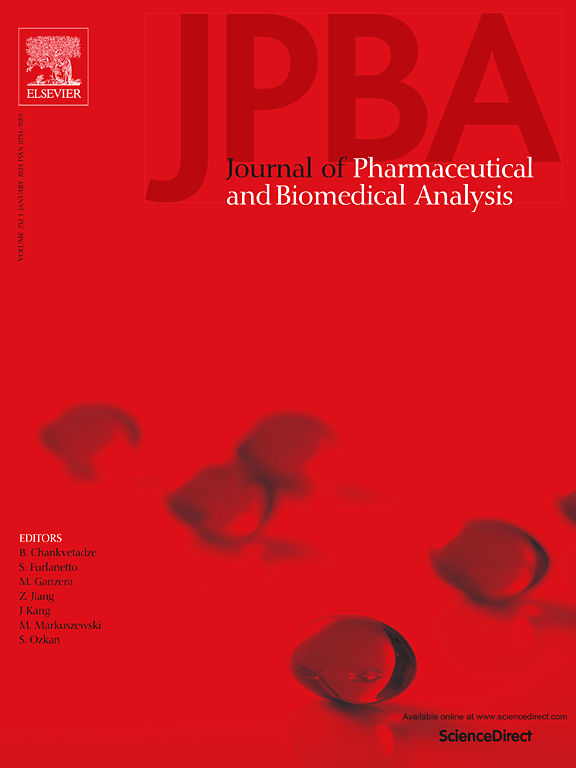基于LC-MS的血清代谢组学分析和奥沙利铂诱导结直肠癌神经毒性的潜在生物标记物
IF 3.1
3区 医学
Q2 CHEMISTRY, ANALYTICAL
Journal of pharmaceutical and biomedical analysis
Pub Date : 2024-10-01
DOI:10.1016/j.jpba.2024.116492
引用次数: 0
摘要
奥沙利铂诱发的周围神经病变(OIPN)是接受奥沙利铂治疗的结直肠癌患者所遇到的一种严重不良反应。然而,OIPN 的发病机制仍不清楚。本研究旨在确定 OIPN 的潜在诊断生物标志物,并发现与该疾病相关的代谢途径。研究收集了 218 名受试者的血清样本,其中包括 OIPN 患者和对照组(CONT)。采用非靶向液相色谱-质谱(LC-MS)血清代谢组学方法对代谢物谱进行了分析。随后,通过多变量统计分析确定并评估了差异代谢物。在这项研究中,OIPN 和 CONT 患者可通过十种重要的代谢物加以区分。结果发现,与 CONT 相比,OIPN 患者的消旋蛋氨酸、O-乙酰肉碱、硬脂酸、氨基己二酸、亚氨基精氨酸、半乳糖酸和全反式维甲酸的水平升高,而 3-甲基-L-酪氨酸、5-氨基戊酸和赤藓糖醇的水平降低。通过接收器操作特征曲线(ROC)分析,外消旋甲硫氨酸、硬脂酸、5-氨基戊酸、赤藓醇、氨基己二酸和全反式维甲酸被确定为 OIPN 有希望的生物标记物。发生显著改变的途径包括氨基酸(精氨酸生物合成、β-丙氨酸代谢、精氨酸和脯氨酸代谢、丙氨酸、天门冬氨酸和谷氨酸代谢、赖氨酸降解以及苯丙氨酸、酪氨酸和色氨酸生物合成)、脂质(亚油酸代谢和不饱和脂肪酸的生物合成)和能量代谢。这项研究通过确定血清生物标志物和剖析代谢途径,为了解 OIPN 的易感机制提供了一个开创性的视角。它是辅助诊断 OIPN 的宝贵资源,有可能降低不良反应的发生率,提高 OIPN 临床诊断的客观性和可靠性。本文章由计算机程序翻译,如有差异,请以英文原文为准。
LC-MS-based serum metabolomics analysis and potential biomarkers for oxaliplatin induced neurotoxicity in colorectal cancer
Oxapliplatin-induced peripheral neuropathy (OIPN) is a significant adverse effect encountered in patients with colorectal cancer undergoing oxaliplatin therapy. However, the pathogenesis of OIPN remains unclear. This study aimed to identify potential diagnostic biomarkers for OIPN and discover the metabolic pathways associated with the disease. Serum samples were collected from 218 subjects, including patients with OIPN and control (CONT). The metabolite profiles were analyzed using nontargeted liquid chromatography-mass spectrometry (LC-MS) serum metabolomics method. Subsequently, differentially altered metabolites were identified and evaluated through multivariate statistical analyses. In this study, patients with OIPN and CONT were distinguished by ten significant metabolites. The levels of racemethionine, O-acetylcarnitine, stearolic acid, aminoadipic acid, iminoarginine, galactaric acid, and all-trans-retinoic acid were increased, whereas the levels of 3-methyl-L-tyrosine, 5-aminopentanoic acid, and erythritol compared were found to be diminished in patients with OIPN when compared to the CONT. Through receiver operating characteristic (ROC) curve analysis, racemethionine, stearolic acid, 5-aminopentanoic acid, erythritol, aminoadipic acid, and all-trans-retinoic acid were pinpointed as promising biomarkers for OIPN. Significantly altered pathways included amino acids (arginine biosynthesis, beta-alanine metabolism, arginine and proline metabolism, alanine, aspartate and glutamate metabolism, lysine degradation, and phenylalanine, tyrosine and tryptophan biosynthesis), lipid (linoleic acid metabolism and the biosynthesis of unsaturated fatty acids), and energy metabolism. This study, by identifying serum biomarkers and dissecting metabolic pathways, offers a groundbreaking perspective on the susceptibility mechanisms underlying OIPN. It stands as an invaluable resource for the adjunctive diagnosis of OIPN, with the potential to diminish the incidence of adverse reactions and to enhance the objectivity and reliability of clinical diagnoses of OIPN.
求助全文
通过发布文献求助,成功后即可免费获取论文全文。
去求助
来源期刊
CiteScore
6.70
自引率
5.90%
发文量
588
审稿时长
37 days
期刊介绍:
This journal is an international medium directed towards the needs of academic, clinical, government and industrial analysis by publishing original research reports and critical reviews on pharmaceutical and biomedical analysis. It covers the interdisciplinary aspects of analysis in the pharmaceutical, biomedical and clinical sciences, including developments in analytical methodology, instrumentation, computation and interpretation. Submissions on novel applications focusing on drug purity and stability studies, pharmacokinetics, therapeutic monitoring, metabolic profiling; drug-related aspects of analytical biochemistry and forensic toxicology; quality assurance in the pharmaceutical industry are also welcome.
Studies from areas of well established and poorly selective methods, such as UV-VIS spectrophotometry (including derivative and multi-wavelength measurements), basic electroanalytical (potentiometric, polarographic and voltammetric) methods, fluorimetry, flow-injection analysis, etc. are accepted for publication in exceptional cases only, if a unique and substantial advantage over presently known systems is demonstrated. The same applies to the assay of simple drug formulations by any kind of methods and the determination of drugs in biological samples based merely on spiked samples. Drug purity/stability studies should contain information on the structure elucidation of the impurities/degradants.

 求助内容:
求助内容: 应助结果提醒方式:
应助结果提醒方式:


